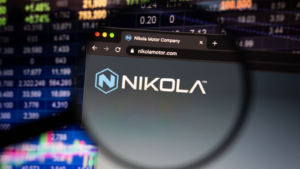Electric vehicles are one of the most exciting trends in the technology space. EVs hold the promise to deliver a great driving experience for consumers while helping the world hit key environmental goals.
However, the growth of the EV market will not necessarily be a straight line upward. There are peaks and valleys along the way, and right now the industry is in a downtrend. Between high-interest rates, falling government subsidies in some markets, and rising competition, EV makers are facing price wars and uneven demand.
The sector as a whole is likely to come out of this downturn just fine. Individual firms, however, may not make it through the bust. It’s time to sell these three EV stocks before things get even worse for these struggling firms.
Rivian Automotive (RIVN)
Source: James Yarbrough / Shutterstock.com
Rivian Automotive (NASDAQ:RIVN) was once one of the most hyped-up electric vehicle companies out there. With its large operating budget and ties to Amazon (NASDAQ:AMZN), traders were enchanted with the firm’s seemingly unlimited potential.
However, reality has proven much less promising. Rivian shares plunged to new all-time lows in February following a dismal earnings report. The company missed the numbers, lowered guidance, and is laying off workers. High-interest rates, macroeconomic uncertainty, and a weakening EV market are all factors in Rivian’s troubles.
Rivian generated a stunning operating loss of $5.7 billion last year. While the company still has a healthy chunk of cash for now, it can’t keep operating at this level of losses for long. Furthermore, the company has a negative gross margin, meaning it is losing money simply manufacturing its vehicles, to say nothing of marketing, R&D, or other overhead expenses.
RIVN stock still has a market capitalization of more than $10 billion. That’s way too high. Given the company’s dire operating results and worsening industry dynamics, there is a good chance RIVN stock will fall to penny stock territory over the next year or two.
Polestar Automotive (PSNY)

Source: Robert Way / Shutterstock.com
Polestar Automotive (NASDAQ:PSNY) shares jumped 25% last week on news that it had secured financing to avoid near-term liquidity problems.
However, more cash may not fix the company’s structural problems. Polestar badly missed its 2023 guidance figures. Deliveries fell short of expectations as consumer demand simply wasn’t there in key markets.
Investors had been banking on Polestar’s relationship with car rental firm Hertz. However, Hertz now appears to be dialing back its EV ambitions as the economics haven’t worked out as planned. Hertz has paused its prior plans to purchase 65,000 vehicles from Polestar.
This speaks to the difficult market in EVs right now. With even big firms like Tesla (NASDAQ:TSLA) cutting prices amid falling demand, it is a terrible landscape for smaller shops like Polestar. Polestar has cash to keep the lights on for now, but unless industry conditions markedly improve, this cash infusion won’t do anything to shore up PSNY’s stock price.
Nikola (NKLA)

Source: Dennis Diatel / Shutterstock.com
Nikola (NASDAQ:NKLA) is still fighting for survival. After the firm’s infamous scandal around rolling a prototype truck down a hill, it would have been easy for the company to give up entirely.
However, Nikola brought in new management and actually built a production facility in Arizona. That was an admirable attempt to build a durable business despite the firm’s inauspicious beginnings.
Unfortunately, it appears that the newer version of Nikola is not going to reach commercial success either. Last quarter, the company delivered just 35 hydrogen fuel cell electric trucks. The company brought in $11 million in revenues, which is better than nothing but not nearly enough. Incredibly, Nikola generated an operating loss of $154 million last quarter alone.
The company raised a large sum of money last quarter, leaving it with $465 million of cash on hand. That might sound good. But shareholders have gotten massively diluted to raise those funds. And even so, at a loss rate of more than $150 million per quarter, Nikola could run out of money again over the next year.
All this adds up to more dilution and potential delisting from the NASDAQ given NKLA stock’s low share price. It’s baffling why this firm still has a $900 million market cap as it faces these challenges.
On the date of publication, Ian Bezek did not have (either directly or indirectly) any positions in the securities mentioned in this article. The opinions expressed in this article are those of the writer, subject to the biedexmarkets.com.com Publishing Guidelines.
Ian Bezek has written more than 1,000 articles for biedexmarkets.com.com and Seeking Alpha. He also worked as a Junior Analyst for Kerrisdale Capital, a $300 million New York City-based hedge fund. You can reach him on Twitter at @irbezek.



